Oceanic Art
There are four regions, they include...
Polynesia (Hawaii and surrounding)
Micronesia
Australia
Melanesia
Polynesia and Micronesia are both from the ancestral culture; Lapita.
ALL of the regions were greatly (and not in a good way - in my opinion) affected by Western influence and colonization. Although, the creations of these people varies, the subject matter remains mostly the same; fertility and the supernatural.
Masks are commonly used in religious ceremonies, and other art forms include; petroglyphs (rock engraving), tattooing, painting, wood carving, stone carving, and textile work are the most common art forms.
Australia
Australia’s first native people are Aboriginal. They came to New Guinea and Australia about 40,000-60,000 years ago. The second came from Southeast Asia. These people lacked writing systems and made art on perishable (not lasting for long) materials. Oceanic people did not think of their work as art, but more as objects created for the practical purpose of use in religious ceremonies, or for use in everyday life. Rock art of Aborigines is the longest continuously practiced artist tradition in the world. They are most known for their rock art, which they still practice even after their contact with Western explorers. They are also known for their dot paintings and are known for dance paintings where they dance with paint on their bodies.
Australia has 3 time periods:
Pre-Estuarine (40,000-6000BC), Oldest and known for red ocher pigment.
Estuarine (6000BC-500AD) when increasing elaborate images appear.
Fresh Water (500AD-Present).
Rock paintings served several functions; ceremonies and amusement. One of the most elaborate collections of rock art in this area is the site Ubirr, a camping ground during wet seasons which has had its rock faces painted many times over thousands of years.
A headdress from New Guinea
Sculpture first appears in Oceania art in New Guinea as a series of stone figures throughout the island. The oldest dates to 1500 BC.
There are three types of sculptures:
1. Mortars – tops contain images and sometimes geometric patters
2. Pestles –tops contain images, often birds or human heads
3. Freestanding figures - humans, animals, and phalluses.
Lapita (ancestors to Polynesia, Micronesia)
Their art is best known for its ceramics. The pieces contain geometric motifs and sometimes anthropomorphic images. Some of the designs may be related to modern Polynesian tattoos and barkcloths. They were created by firing a comblike tool that stamped the designs on to wet clay. The ceramics were used in cooking, serving and storing food. It was functional.
source. Ceramic pieces with the patterns.
Micronesia is second wave settlers of Oceania.
Wood carving by men flourishes in the region. Stylized bowls, canoe ornaments, ceremonial vessels, and sometime sculptured figures. Women created textiles and ornaments, like bracelets and headbands. Micronesian art is simple and functional, but usually high standard of quality. They made the best possible use of what few natural materials they had available to them. After western cultures influenced the Micronesia people sculptural art forms ceased to exist. But architecture and weaving continued. In the 20th century there was a revived interest in traditional art forms.
Mask from the Maori culture of New Zealand
Polynesia is also from Lapita’s culture. They include Hawaiian islands, New Zealand, Tahiti, and Easter Isalnd. Polynesian art is characteristically ornate and often meant to contain supernatural power. In the 19th Century, depopulation of areas due to slave raiding and Western diseases disrupted many cultures. Because of the conversion to Christianity, the loss of many tradition cultural and artworks occurred, specifically sculpture. Secular art forms continued, such as carving and textile work.
Melanesia
Typically the art is highly decorative and portrays exaggerated forms, often of sexual themes. It’s mostly made in connection with ancestors, hunting and cannibalism. Often they they used the context of spiritual rituals, for example; elaborate masks. After the 1600 and the increase of European explorers much of their art was lost.
In 1600, Melanesia, like the other regions of Oceania, saw increasing encounters with European explorers. It wasn't until the latter half of the 19th century however, that westernization began to takes its toll. Some traditional forms of art went into decline, but others like sculpture survived and even thrived in the region. Not until more of the islands was explored by the western powers that the sheer diversity of Melanesian art began to be seen. By the 20th century, Melanesian art began to find its way to the West and had a profound impact on contemporary artists. However, a great cultural disruption followed the WWII, and much traditional art began to decline or be destroyed. This was followed decades later by a new found appreciation for their native art forms.
Sources 1. 2.
want a simple version of these notes? The Google Doc of my notes handout for my students available here.
Happy Oceanic Art Educating.
If you have more references and or information about oceanic art I'd love to see it, link it in the comments below!





No comments:
Post a Comment